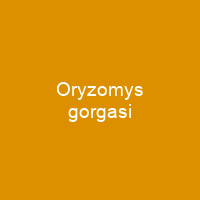Oryzomys gorgasi

Oryzomys gorgasi is a medium-sized, brownish species with large, semiaquatically specialized feet. It is known from only a few localities, including a freshwater swamp in the lowlands of northwestern Colombia and a mangrove islet in northwestern Venezuela. Its diet includes crustaceans, insects, and plant material, and parasitic nematodes infect it. The species is listed as endangered by the International Union for Conservation of Nature.
About Oryzomys gorgasi in brief
 Oryzomys gorgasi is a medium-sized, brownish species with large, semiaquatically specialized feet. It is known from only a few localities, including a freshwater swamp in the lowlands of northwestern Colombia and a mangrove islet in northwestern Venezuela. Its diet includes crustaceans, insects, and plant material, and parasitic nematodes infect it. It formerly occurred on the island of Curaçao off northwestern Venezuela; this extinct population has been described as a separate species. The species is listed as “Endangered” by the International Union for Conservation of Nature due to destruction of its habitat and competition with the introduced black rat. Oryzoms is the southeasternmost representative of the genus OryZomys, which extends north into the eastern United States. O.S. Voss and Weksler examined the two and concluded that they represented the same species on the basis of direct comparisons and a phylogenetic analysis.
Oryzomys gorgasi is a medium-sized, brownish species with large, semiaquatically specialized feet. It is known from only a few localities, including a freshwater swamp in the lowlands of northwestern Colombia and a mangrove islet in northwestern Venezuela. Its diet includes crustaceans, insects, and plant material, and parasitic nematodes infect it. It formerly occurred on the island of Curaçao off northwestern Venezuela; this extinct population has been described as a separate species. The species is listed as “Endangered” by the International Union for Conservation of Nature due to destruction of its habitat and competition with the introduced black rat. Oryzoms is the southeasternmost representative of the genus OryZomys, which extends north into the eastern United States. O.S. Voss and Weksler examined the two and concluded that they represented the same species on the basis of direct comparisons and a phylogenetic analysis.
O.M. curasoae is a junior synonym of the earlier described O. gorgasi. Many aspects of the current classification system remain unclear and it is likely that the true classification underestimates the true diversity of the tribe of the group. The tribe is classified in the subfamily Sigmodontina of family Cricetidae, along with hundreds of other species of mainly small rodents, including the marsh rice rat and other rodents of South America and the United States. The group is classified as a diverse assemblage of over hundred species of rodents of over a hundred different taxonomic levels in subfamily ORYzomyini, and on a higher taxonomic level in the family Sigmodeina. The genus is also known as Gorgas’s oryzomys or GorgAs’s rice rat, and is long and coarsely ochraceous above raceous below race. Ory Zomys is a gorgasomyine oryzomyine with small ears and small ears, similar to the rice rat in general.
You want to know more about Oryzomys gorgasi?
This page is based on the article Oryzomys gorgasi published in Wikipedia (as of Oct. 30, 2020) and was automatically summarized using artificial intelligence.












